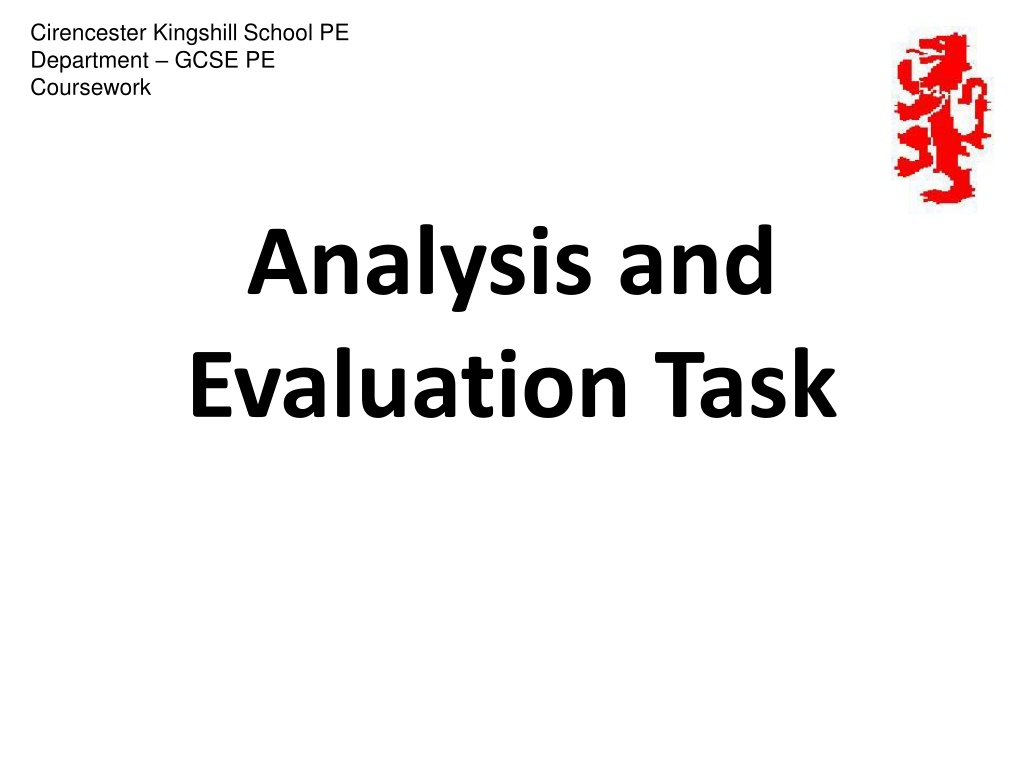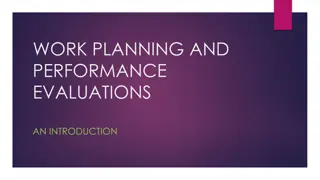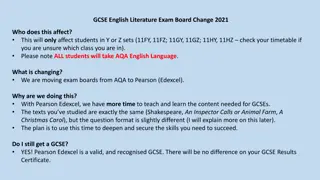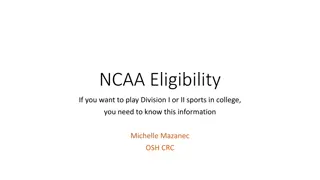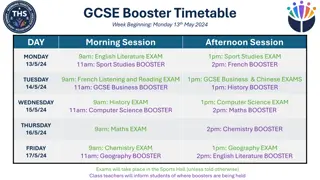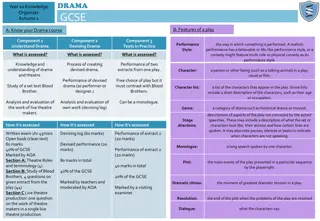Enhancing Performance Through GCSE PE Coursework Evaluation
In the GCSE PE coursework analysis and evaluation task at Cirencester Kingshill School, students are required to assess mark allocation, identify strengths and weaknesses, devise sessions to combat weaknesses, and create evaluation plans focusing on training methods like circuit training. The emphasis is on justifying choices to improve weaknesses and align training with specific sport-related needs, leading to overall skill enhancement and performance improvement.
- GCSE PE coursework
- Cirencester Kingshill School
- evaluation task
- circuit training
- performance improvement
Uploaded on Oct 02, 2024 | 0 Views
Download Presentation

Please find below an Image/Link to download the presentation.
The content on the website is provided AS IS for your information and personal use only. It may not be sold, licensed, or shared on other websites without obtaining consent from the author. Download presentation by click this link. If you encounter any issues during the download, it is possible that the publisher has removed the file from their server.
E N D
Presentation Transcript
Cirencester Kingshill School PE Department GCSE PE Coursework Analysis and Evaluation Task
Mark Allocation Analysis is worth 15 marks Evaluation is worth 10 marks Identify strengths and weakness MUST JUSTIFY!!! Devise a session combating a weakness. Comment on a different part of the spec. next_btn_colour
Identify Strengths STRENGTH My strength is - ______________ (refer to a Component of Fitness and give a clear definition) STRENGTH My strength is _______________ (refer to a specific skill/technique on the spec or tactic/strategy/aspect of choreography) Shooting Tackling Ins and Out when shooting in Netball Speed Agility Muscular strength Endurance next_btn_colour
Identify Weakness WEAKNESS My weakness is - ______________ (refer to a Component of Fitness and give a clear definition) WEAKNESS My weakness is _______________ (refer to a specific skill/technique on the spec or tactic/strategy/aspect of choreography) Shooting Tackling Ins and Out when shooting in Netball Speed Agility Muscular strength Endurance next_btn_colour
Evaluations CREATE A SESSION PLAN THAT COVERS YOUR WEAKNESS Clearly identify and describe training method have you selected that will improve both your weaknesses. The method of training that I have chosen is Circuit Training. Circuit training involves performing a series of exercises in a special order called a circuit. Each activity takes place at a 'station'. It can be manipulated to improve a range of components of fitness such as; speed, agility and coordination. Justify why you have selected that training method to combat both your identified weaknesses. I have chosen this method as I am able to focus my session on improving my agility which is my first weakness and it can also combat my second weakness of dodging away from my defender. By creating a range of different stations I avoid any form of tedium as each station is different. I also have made some of the stations sports specific. This means that I will be able to target my weakness and relate it directly to my sport. Circuit training is also easy to progress, therefore as I complete my training programme over a series of 6 weeks I am able to change the frequency of the stations, the time spent on the stations and change the type of station. This will cause my body to overload and ultimately progress.
Evaluations Outline and describe one session of your chosen training type focusing on the weaknesses. Include a Warm Up and Cool Down Station Description and teaching points Image Time spent on station Zig Zag Shuttles Squat and side step Pole weave Hurdles Ladders Explain how your training programme will help improve your weaknesses. next_btn_colour Include teaching points
Evaluations COMMENT ON A DIFFERENT ELEMENT OF THE SPEC Identify another part of the specification in relation to the weakness and your training programme. Justify how knowledge of this area could improve performance (provide detail). How can we use this knowledge in our future performances? Diet Arousal Training thresholds Injury Oxygen Debt Recovery after exercise Somatotypes Mechanical advantage Training Seasons Skill Classification Goal Setting Information Processing Guidance and Feedback Aggression Personality types
Theory for weakness one: Arousal control My chosen area of the course that I think can help my rugby performance is arousal control. Arousal is defined as a physical and mental (physiological & psychological) state of alertness/ readiness varying from deep sleep to intense excitement/ alertness. In my case my arousal often shows in how focused, excited, aggressive and alert I am. Every skill in rugby (or any other sport) has a perfect level of arousal called the optimal point. You can be over or under aroused depending on the arousal level needed to do the skill. The perfect arousal level is known as the optimal point as shown in the Inverted U theory below. With specific reference to my mauling, I do believe that I am often over aroused when entering a maul, particularly as a supporting player. I tend to approach a maul with very high arousal, knowing that I must try to help our player keep possession. In the weakness I gave in my analysis, I was aggressive in my approach to the maul and lost focus, entering the maul from the side and being penalised. By working on how to control my arousal I think I can improve my performance in mauls (and other areas of my game) in future. I am going to use two arousal control techniques: deep breathing mental rehearsal Deep breathing involves taking slow, deep breaths so that the body can relax. In my case, I will aim to do this in between phases of play , trying to relax my muscles and focus on my breathing. If for example a penalty is given, I will take the chance to slow my breathing rate and take deeper breaths. If a maul then follows as play starts, hopefully my arousal will be closer to what is needed. For a maul, a fairly high level is needed, but if it is too high and not controlled, you can end up doing something wrong like I did in my weakness. This is shown in the diagram below- marked as an X. : 1205 Mental rehearsal is a technique, which involves picturing the perfect performance in your head. For a weakness like mauling, I could do this when looking at mauls I am not involved in- picturing mentally how I would enter the maul if I needed to. As a winger I get lots of time without the ball and can picture the correct technique in moments of not being involved. Picturing the correct technique will hopefully help me focus and control my arousal level so that I am at the correct level for each skill I do- particularly when mauling. I can also use mental rehearsal when approaching a maul, picturing how my technique will be perfect before actually joining as a player. My mental rehearsal can also be used in training drills when I train on a Tuesday night with my team. If I am the ball carrier, I can picture myself taking the hit and turning in between goes of the drill. This should focus my thoughts and control my arousal.
TOP TIPS: Be really specific with your strengths and weaknesses. Provide lots of detail. Use sports specific terminology. Use images to support the strengths and weakness / images of yourself are even better!!!
10 points to remember: Analysis and evaluation 1. DO NOT provide individual feedback on content. Generic process feedback can be given 2. Students can be told about the process 3. The work can be written or verbal 4. It is possible to do the analysis verbally and evaluation written (or vice versa) 5. Candidates chosen for moderation will also have to provide their A&E 6. Any verbal interviews must be recorded 7. For verbal interviews, it is ok for students to bring in brief notes to assist 8. Students can do their analysis and evaluation on any activity- including those within the specification out with the three assessed activities 9. Students can do their analysis and evaluation on another student 10. Teachers should avoid leading questions. Open-ended questions should be used.
COURSE WORK REVIEW Action points 2019 A1. Strengths and Weaknesses Add detail use coaching points, compare to a perfect model. Include images and use arrows to annotate. Justify your strengths and weakness! Use at least 2/3 sporting examples! Why they are useful for you and your position. Explain the outcome , why did / didn t you achieve success? Add depth use clear / recognised terminology that identifies what you do / don t do well. Definitions! Basic explanation what is a scrum?! You do not need to do 2 strengths and 2 weaknesses. You can just do 1 in loads of depth.
A2. Evaluation Action Plan Provide a clear and detailed justification of your chosen weakness why is it the most important one for you to improve? Your weakness your improving needs to be a weakness you have already identified!! Definition of method of training and strengths and weakness. Add depth include the energy system / training zone you plan to work in with a reason why! What is training zones? Which ones are important for you? A3. Evaluation Action plan / Description of Session Add detail Personalise the Principles of Training (SPORT) You will not add any marks by simply giving a generalised description of what the PoT s are!!! Ensure this explanation is linked to your weakness! Give more detail regarding your session. Coaching points
A4. Evaluation How can you improve over time? Explain how hard you are working. Intensities are required, work it out Maximal = Strength/Speed anaerobic (85-95% of max H/R)? Sub Maximal = Muscular Endurance on the threshold between an/aerobic (75-85% of max H/R)? Aerobic = C/V continuous (60-80% of max H/R)? A5. Evaluation - Link to Theoretical principle Ensure your principle is explained. It must link to your weakness(s) and/or your chosen method of training!
Extended Writing Explain and justify whether the different types of strength are required for a triple jumper. (9 marks) I D E A IDENTIFY DESCRIBE EXPLAIN APPLY
IDENTIFY To begin with, identify what the question is asking you to do. Then identify the topic or point from the GCSE specification that you think links to the question. Sentence starter:What is this question asking me to do? Justify = support a case with evidence. One type of strength that would be useful for a triple jumper is DESCRIBE Now, simply describe what this is / give a definition if possible. (Tip: keep away from cause& effect connectives i.e. because as this is the next stage!) Sentence starter: The athlete would This is when
EXPLAIN Explain the definition/point in your own words. What does it mean? Show you fully understand the topic. How does your point relate to the question? Connectives: because so thus consequently therefore ANALYSE/ APPLY Link the points you have made to specific sporting example / what are positive and negative effects of the things you have identified in relation to the exam question? How will your performer use this point/topic? Sentence starter: For example
Apply it extended writing planning Type of strength Definition Aspect of triple jump that it is/is NOT relevant How that type of strength will be beneficial/NOT beneficial for a triple jumper
Apply it extended writing planning Type of strength Definition Aspect of triple jump that it is/is NOT relevant How that type of strength will be beneficial/NOT beneficial for a triple jumper Explosive strength
Apply it extended writing planning Type of strength Definition Aspect of triple jump that it is/is NOT relevant How that type of strength will be beneficial/NOT beneficial for a triple jumper Explosive strength Amount of force exerted in one quick muscle contraction
Apply it extended writing planning Type of strength Definition Aspect of triple jump that it is/is NOT relevant How that type of strength will be beneficial/NOT beneficial for a triple jumper Explosive strength Amount of force exerted in one quick muscle contraction Used in the final phase; take off
Apply it extended writing planning Type of strength Definition Aspect of triple jump that it is/is NOT relevant How that type of strength will be beneficial/NOT beneficial for a triple jumper It will give them more height; allowing them to jump higher and further; gaining a greater distance; more likely to win competition. Explosive strength Amount of force exerted in one quick muscle contraction Used in the final phase; take off
Apply it extended writing planning Type of strength Definition Aspect of triple jump that it is/is NOT relevant How that type of strength will be beneficial/NOT beneficial for a triple jumper TJ is a dynamic movement from beginning to end, therefore no stillness. Static strength Amount of force exerted on an object you cannot move. Not used in TJ.
Apply it extended writing planning Type of strength Definition Aspect of triple jump that it is/is NOT relevant How that type of strength will be beneficial/NOT beneficial for a triple jumper Run up and take off interlinked, so the final movement could be maximal, along with explosive. Would give more height/distance. Maximal strength Greatest force possible in a single maximum muscle contraction. Not used on it s own in TJ. Perhaps used within take off.
Apply it extended writing planning Type of strength Definition Aspect of triple jump that it is/is NOT relevant How that type of strength will be beneficial/NOT beneficial for a triple jumper Dynamic strength reduces onset of fatigue in legs, resulting in my force for take off, therefore height/ distance. Dynamic strength Amount of force that can be exerted repeatedly by a muscle. Run up, leg momentum. In air, to gain distance.
Application Explain and justify whether the different types of strength are required for a triple jumper. (9 marks) I D E A IDENTIFY DESCRIBE EXPLAIN APPLY REFLECTION & PROGRESSION
